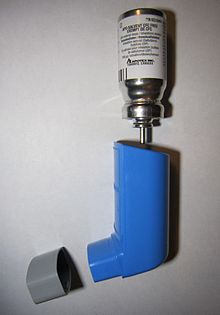Management
A specific, customized plan for proactively monitoring and managing symptoms should be created. Someone who has asthma should understand the importance of reducing exposure to allergens, testing to assess the severity of symptoms, and the usage of medications. The treatment plan should be written down and adjusted according to changes in symptoms.[99]
The most effective treatment for asthma is identifying triggers, such as cigarette smoke, pets, or aspirin, and eliminating exposure to them. If trigger avoidance is insufficient, medical treatment is recommended. Medical treatments used depends on the severity of illness and the frequency of symptoms. Specific medications for asthma are broadly classified in to fast acting and long acting.[100][101]
Bronchodilators are recommended for short-term relief of symptoms. In those with occasional attacks, no other medication is needed. If mild persistent disease is present (more than two attacks a week), low-dose inhaled glucocorticoids or alternatively, an oral leukotriene antagonist or a mast cell stabilizer is recommended. For those who suffer daily attacks, a higher dose of inhaled glucocorticoid is used. In a severe asthma exacerbation, oral glucocorticoids are added to these treatments.[90]
[edit]Lifestyle modification
Avoidance of triggers is a key component of improving control and preventing attacks. The most common triggers include: allergens, smoke (tobacco and other), air pollution, non selective beta-blockers, and sulfite-containing foods.[90][102]
[edit]Medications
Medications used to treat asthma are divided into two general classes: quick-relief medications used to treat acute symptoms; and long-term control medications used to prevent further exacerbation.[103]
- Fast acting
- Short acting beta2-adrenoceptor agonists (SABA), such as salbutamol (albuterol USAN) are the first line treatment for asthma symptoms.[3]
- Anticholinergic medications, such as ipratropium bromide provide addition benefit when used in combination with SABA in those with moderate or severe symptoms.[3] Anticholinergic bronchodilators can also be used if a person cannot tolerate a SABA.[9]
- Older, less selective adrenergic agonists, such as inhaled epinephrine, have similar efficacy to SABAs.[104] They are however not recommended due to concerns regarding excessive cardiac stimulation.[105]
- Long term control
- Glucocorticoids are the most effective treatment available for long term control.[106] Inhaled forms are usually used except in the case of severe persistent disease, in which oral steroids may be needed.[106] Inhaled formulations may be used once or twice daily, depending on the severity of symptoms.[107]
- Long acting beta-adrenoceptor agonists (LABA) have at least a 12-hour effect. They are however not to be used without a steroid due to an increased risk of severe symptoms.[108][109][110] In December 2008, members of the FDA's drug-safety office recommended withdrawing approval for these medications in children. Discussion is ongoing about their use in adults.[111]
- Leukotriene antagonist ( such as zafirlukast) are an alternative to inhaled glucocorticoids, but are not preferred. They may also be used in addition to inhaled glucocorticoids but are second line to LABD.[106]
- Mast cell stabilizers (such as cromolyn sodium) are another none preferred alternative to glucocorticoids.[106]
- Delivery methods
Medications are typically provided as metered-dose inhalers (MDIs) in combination with an asthma spacer or as a dry powder inhaler. The spacer is a plastic cylinder that mixes the medication with air, making it easier to receive a full dose of the drug. A nebulizer may also be used. Nebulizers and spacers are equally effective in those with mild to moderate symptoms however insufficient evidence is available to determine whether or not a difference exist in those severe symptomatology.[112]
- Safety and adverse effects
Long-term use of glucocorticoids carries a significant potential for adverse effects. The incidence of cataracts is increased in people undergoing treatment for asthma with corticosteroids, due to altered regulation of lens epithelial cells.[113] The incidence of osteoporosis is also increased, due to changes inbone remodeling.[114][115]
[edit]Other
When an asthma attack is unresponsive to usual medications, other options are available for emergency management.
- Oxygen is used to alleviate hypoxia if saturations fall below 92%.[116]
- Magnesium sulfate intravenous treatment has been shown to provide a bronchodilating effect when used in addition to other treatment in severe acute asthma attacks.[117][118]
- Heliox, a mixture of helium and oxygen, may also be considered in severe unresponsive cases.[118]
- Intravenous salbutamol is not supported by available, evidence and is thus used only in extreme cases.[116]
- Methylxanthines (such as theophylline) were once widely used, but do not add significantly to the effects of inhaled beta-agonists.[116]
- The dissociative anesthetic ketamine is theoretically useful if intubation and mechanical ventilation is needed in people who are approaching respiratory arrest; however, there is no evidence from clinical trials to support this.[119]
[edit]Complementary medicine
Many asthma patients, like those who suffer from other chronic disorders, use alternative treatments; surveys show that roughly 50% of asthma patients use some form of unconventional therapy.[120][121] There is little data to support the effectiveness of most of these therapies. Evidence is insufficient to support the usage of Vitamin C.[122] Acupuncture is not recommended for the treatment as there is insufficient evidence to support its use.[123][124] Air ionisers show no evidence that they improve asthma symptoms or benefit lung function; this applied equally to positive and negative ion generators.[125]
Dust mite control measures, including air filtration, chemicals to kill mites, vacuuming, mattress covers and others methods had no effect on asthma symptoms.[126] However, a review of 30 studies found that "bedding encasement might be an effective asthma treatment under some conditions" (when the patient is highly allergic to dust mite and the intervention reduces the dust mite exposure level from high levels to low levels).[127] Washing laundry/rugs in hot water was also found to improve control of allergens.[9]
A study of "manual therapies" for asthma, including osteopathic, chiropractic, physiotherapeutic and respiratory therapeutic manoeuvres, found there is insufficient evidence to support or refute their use in treating.[128] The Buteyko breathing technique for controlling hyperventilation may result in a reduction in medications use however does not have any effect on lung function.[129]


No comments:
Post a Comment